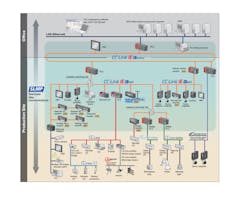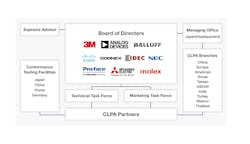CC-Link IE’s Embrace of TSN and Gigabit Ethernet
Of all the open, industrial-Ethernet network protocols out there, why should you consider using Control and Communication Link Industrial Ethernet (CC-Link IE)?
“Performance,” is the answer to this question according to Tom Burke, global director of industry standards at Mitsubishi Electric Automation and global strategic advisor for the CC-Link Partner Association (CLPA) Americas. “While other solutions are typically limited to 100Mb architectures, CC-Link IE has supported 1Gb Ethernet for several years now.”
CC-Link IE is the high-speed, large-capacity member of the CC-Link family of open networks that share the common CC-Link protocol but differ in the transport medium. Using industrial Ethernet as the transport medium, CC-Link IE communicates from the information technology (IT) layer to the field layer. In addition to its ability to integrate distributed I/O, safety and motion control applications, the Ethernet-based network also fosters the convergence of IT and operational technology (OT), according to Burke.
A memory-mapped profile defines data for each type of product supporting the memory map. “This definition includes the control signal and data layout,” says Burke. Because multiple vendors can develop CC-Link compatible products to match this profile, it allows users to replace one product brand with another without needing to change connections or control programs.
Yet another contributor to CC-Link’s performance is its redundant loop topology. “Each station continues communication by looping back upon detection of a broken cable or station error,” says Burke. “This integrated redundancy is provided without additional equipment and without increasing network cost adoption of standard Ethernet cables, connectors and adapters.”
This combination has made motion control a sweet spot for CC-Link use. “The greatest test for performance comes in applications with motion control, such as CNC (computer numerical control) as well as bottling and filling, printing, packaging lines and converting lines,” notes Burke.
Evolution from fieldbus
This motion control sweet spot for CC-Link has existed since the original version was developed by Mitsubishi Electric in November 1996. The original CC-Link was a high-speed fieldbus network that could simultaneously handle both control and information data. “With the high communication speed of 10 Mbps, CC-Link could achieve a maximum transmission distance of 100 meters and connect to 64 stations,” notes Burke.
In the years since its initial release, CC-Link has evolved with the advances made in networking technology and the emergence of new concepts in data transfer (protocol design).
An important milestone in CC-Link’s evolution was its proliferation as a fully open protocol. Mitsubishi Electric took the first step toward achieving this with the release of its specifications in June 2000. Then, in November of that year, the automation vendor joined with six partner companies to form the CLPA, a third-party organization that manages the evolution and proliferation of CC-Link. By April 2001, the CLPA had established six overseas bases in the major manufacturing centers around the world.
Today, the CLPA is based in Nagoya, Japan, and governed by a board of directors from ten companies: 3M, Analog Devices, Balluff, Cisco, Cognex Corp., IDEC Corp., Mitsubishi Electric, Molex, NEC and Pro-face. Although the board reviews and approves any updates to the CC-Link specifications, the bulk of the development work is done through the CLPA’s Technical Task Force. “The task force also develops specifications for conformance testing, network infrastructure and other vital technical guidance,” says Burke.
Gigabit Ethernet use
Gigabit Ethernet-based industrial networks appeared on the scene in late 2007. In October of that year, the CLPA announced its CC-Link IE Control specifications for high-bandwidth controller-to-controller communications. These specifications would be the first part of a wider CC-Link IE integrated network concept that the CLPA would announce in November 2007. To round out the integrated network concept, a second set of specifications called CC-Link IE Field would be forthcoming to define field-level communications.
Control specifications for CC-Link IE were released in January 2008, and the field specifications were released in November 2009. Since then, the CLPA has continued to develop specifications that add functionality and widen CC-Link IE’s capabilities. For example, the organization released functional specifications in April 2011 to enable safety communications and in October 2012 to support energy management.
Meanwhile, recognizing the value of standards, the CLPA has also pursued certification with international standards bodies. For example, CC-Link received SEMI E54.12 certification in May 2001, ISO 15745-5 certification in April 2006, and IEC 61158 and IEC 61784 certifications in December 2007. Once CC-Link IE was launched, the CLPA again pursued IEC 61158 and IEC 61784 certifications, acquiring them in August 2014.
“CLPA has always focused on open networks and the ability for suppliers to quickly develop and certify products, and bring them to market,” notes Burke. “The key to our strategy is adoption and easy, high-quality certification—making sure that the products are validated against the standards for the highest level of interoperability and adherence to the specifications.”
Embracing TSN
The most recent major milestone for CC-Link IE occurred in November 2018 with the release of CC-Link IE TSN specifications supporting the new time-sensitive networking bridging standards (IEEE 802) being developed and promulgated by the Institute of Electrical and Electronics Engineers. “TSN is a game-changing technology that provides high-speed performance and allows the existing CC-Link IE technology to evolve to the next generation,” observes Burke.
The value of this capability has led the major industrial-Ethernet protocol organizations to look at adding TSN to their specifications. “What’s most interesting is how the organizations, and also the suppliers that are part of those organizations, are recognizing this particular technical innovation as a key strategy for the end users and system integrators to enhance their systems with new and data-centric capabilities,” says Burke.
He adds that the CLPA was the first organization to release a specification supporting TSN and has been delivering TSN solutions through Mitsubishi Electric and CLPA Partners since 2018. “CLPA has been working with other organizations to do the necessary conformance validation to ensure that the specifications and the products will be able to coexist on the physical wire of the TSN technology as specified,” he continues. This work has been occurring through the TSN Industrial Automation Conformance Collaboration (TIACC.net).
Industrial applications
Burke believes that CC-Link IE TSN will excel in complex applications that need a mix of redundancy, speed and determinism to process large volumes of data. One example he provided is of a next-generation water and wastewater treatment plant wanting to reap the benefits of Industry 4.0. “Water and wastewater treatment plants of the future will be data-driven, and data visibility will be one of the most important elements for optimizing operations,” observes Burke.
“Even for existing plants,” he continues, “the latest advances in industrial automation and predictive analytics can improve treatment operations, while reducing energy and chemical use and minimizing operating costs.” Data-driven alarms, for example, can prompt operators to shorten energy-intensive processes or make fine adjustments that improve efficiency.
Because these capabilities can generate large data flows, Burke recommends the gigabit bandwidth of an Ethernet-based network to handle those flows both now and in the future. “Existing 10 Mbit/s and 100 Mbit/s solutions are unlikely to be sufficient,” he says. “That’s why water and wastewater treatment plants should favor 1 Gbit/s technologies.”
The determinism and redundancy in a CC-Link IE TSN network can also help with handling large data flows. Built-in redundant loop topologies increase network availability, and a token-passing protocol supports deterministic data-transmission control that minimizes packet losses and delays. To enhance the determinism provided by CC-Link, the TSN capabilities can accurately synchronize network devices and prioritize time-critical traffic among devices such as I/O, drives or PLCs.
“By assigning lower priorities to data transmitted from devices that are not as time-critical—such as HMIs and supervisory PCs—processing facilities can make sure that bandwidth is assigned first to high-priority messages in periods of high traffic,” says Burke. “Key processes can continue to run without any interruption that could reduce overall throughput.”
Besides permitting the prioritization of specific data traffic, TSN also allows the scheduling of bandwidth allocations for data flows to optimize bandwidth utilization.
Burke adds that the ability to prioritize data traffic is growing in importance as OT and IT data increasingly converge in Industry 4.0 applications. “By merging and sharing key OT and IT networks across the enterprise, it is possible to truly leverage the power of data,” he concludes.






